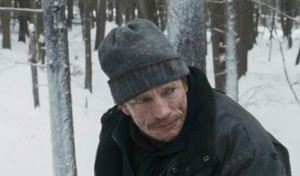Thomas Haden Church triumphs over cold in ‘Whitewash.”
 By Richard Crouse – Metro Canada
By Richard Crouse – Metro Canada
It wasn’t the wind and snow that Thomas Haden Church found “punishing” when shooting the new psychological thriller Whitewash in northern Quebec, but the lack of it.
“You know how it goes,” he says. “You shoot one day and it’s the perfect conditions and two days later it’s 50 degrees (10 degrees Celsius) and you have to figure out a way to make it match. We had blizzards and we had giant fans with cornstarch.
“When we started shooting there was a storm blowing in but as God would have it three hours later there’s not a flake of snow floating through the air so they pull out the eight-foot fans and crank up the Corvette engines that drive them and start hucking cornstarch at me.
“It is still cold as all get out, and with those fans blowing sometimes you wish the blizzard would come back and they’d turn the fans off. Those fans will fling stuff at you at sixty miles an hour. Those things are punishing to stand in front of.”
The cornstarch plays a crucial role in the film’s opening and defining scene. During a whiteout snowstorm — enhanced with the white, fluffy thickener for extra effect — Church’s character Bruce takes a wild, drunken ride on a bulldozer that leaves a man dead.
Unnerved, he hides the body in a snow bank and lams it to the deep woods to avoid police and clear his head. “When I read it a buddy of mine who works with me said, ‘You know, sometimes you read ’em and you know what you know. You gotta go.’ I knew as soon as I read Whitewash I had to go. The challenges, the character, the uniqueness of the setting, the emotional complexity of what he goes through. There is tragedy but I think by the end of the movie there is this affirmation that everybody landed on the mortal coil where they were supposed to be.”
Church is in virtually every scene and delivers an extraordinary, minimalist performance.
He doesn’t appear to be doing much, but subtly rides the lines between sanity and insanity, between absurdity and logic, leaving the viewer off balance as the film veers between the present and flashbacks.
“Even as far back as working in television comedy as I did, I always wanted more nuance, more reflection, more moments of whatever the whisper line between comedy and drama is,” he says.
“That really is defined by human circumstance and human behavior. Even when we were promoting this picture that I did called Sideways, we’d do these big Q&As and one time this guy said, ‘It must be really interesting.
In the dramatic scenes you make very dramatic choices and in the comedic scenes you make very comedic choices.’ No man, maybe it sounds a bit elitist or pseudo-intellectual but I make human choices. I’m just trying to play a real guy.”
